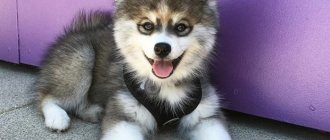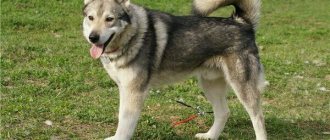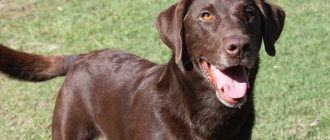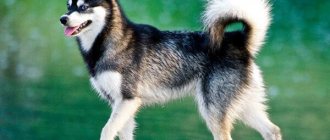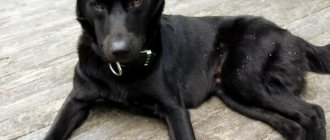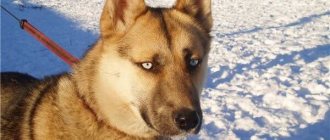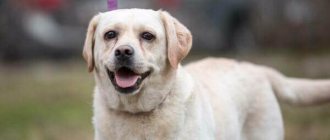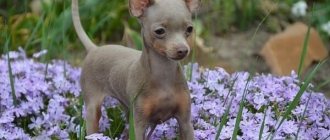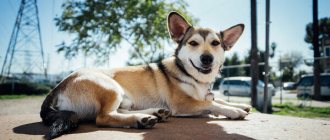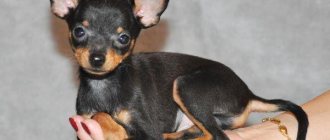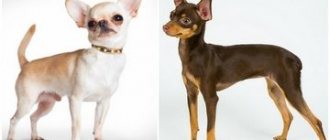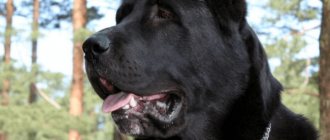Today, many dog breeders prefer to have puppies for beauty, aesthetics and love, since they do not require a special approach to training, daily sports training and the need to live on the street as a guard. In order to develop a new decorative variety, a calm, independent Husky was crossed with a miniature Spitz. As a result, a stunning Pomsky breed was born, which immediately gained love and popularity on the Internet. A pretty appearance and a kind character are the main qualities of a furry, four-legged friend.
Characteristics and description of the breed
Decorative dogs were bred through numerous experiments and experiments. Character traits, like external data, are completely inherited from parents, undergoing genetic changes. At the moment, the breed does not have a large-scale distribution, since it has not been amenable to the study of characteristic features and the development of general standards.
Aggressiveness
They don't know what aggression is. They are absolutely defenseless, so they need a strong, good-natured and attentive mentor. Trying to raise a Pomsky to be a protector is a waste of time and effort.
Activity
Very playful and playful pets. They love to take long walks, run and play. They often make good companions. When the opportunity arises, they will try to escape in search of exciting adventures and fun. Therefore, it is necessary to monitor the dog and teach it from childhood to calmness and moderate activity.
Training
They enjoy training and learning new teams. They love to learn new things. They quickly master standard training and listen to their owner if he pampers them with love and treats.
Pomskies do not tolerate harsh language or threats. If pets are not surrounded by love and affection, they begin to live an independent life without the help of household members.
Shedding
They shed heavily, especially during adolescence. The breed is not suitable for those who are prone to allergies. During the change of undercoat, it is necessary to comb several times a day.
Need for care
They do not require expensive, lengthy care procedures. It is enough to comb the fur during the molting period, clean the ears, eyes and wipe the paws after a walk. Bath once every 2 weeks.
Friendliness and attitude towards children
They are very self-sufficient and freedom-loving, so in some periods they may not pay attention to the people around them and strangers. They also treat children with indifference and sometimes play with them, but without fanaticism.
Health
From birth they have strong immunity and resistance to external irritants. The only caveat is the inheritance of chronic diseases from parents.
Attitude towards loneliness
They cannot stand being alone for a long time; it is important for them to constantly be near their beloved owner. With proper upbringing, they patiently wait for members of the household to arrive and know how to keep themselves busy.
If a dog is alone in an apartment for a long time, it needs entertainment items, such as toys, exercise equipment and special houses.
Maintenance cost
The maintenance depends entirely on the daily diet and type of food, the number of trips to the veterinarian and visits to the hairdresser per month. On average, the amount is similar to that spent on keeping a Pomeranian.
Read Prague Rat - description and photo of a miniature dog
Intelligence
Developed intelligence and increased learning ability. Pomskies can hardly be called lazy pets; they are always active, determined and attentive.
Noise
They can be silent if properly raised and explained the importance of silence at certain moments. Some “instances” are real talkative fidgets who cannot be calmed down.
Security qualities
There are no security qualities. If danger threatens, the dog can attack the enemy, but most often it is timid and does not know how to defend itself. This is an ornamental breed that does not tolerate conflicts.
Lifespan
The lifespan of a pet is determined by its health and inherited diseases from its parents. On average, dogs live up to 14-15 years.
Life expectancy is determined by proper care, regular examinations and timely vaccinations.
Breeding
To breed a Pomsky, it is enough to take a healthy Spitz male and a healthy Husky female. The main thing in choosing partners is the absence of genetic diseases and marriage.
You can mix two individuals of the same species, but such mating is allowed only in nurseries where there are experienced specialists. The difficulty of such crossing is that the genetic characteristics of the litter are unpredictable. If one mating results in beautiful Pomskys, subsequent ones may result in puppies that are completely different from the first litter. They may have more developed Husky or Pomeranian characteristics.
Mating
The peculiarity of mating is the difference in height between the dog and the bitch. A Spitz cannot naturally impregnate a Husky, so specialists have to resort to the method of artificial insemination. The bitch is injected with male sperm with a special syringe at a certain time of estrus.
It is forbidden to breed a Spitz female and a Husky male, as a small dog will not be able to bear large puppies. This will lead to the death of the animal.
Caring for puppies
The first time after birth, puppies need special care from the mother and the breeder. The owner must provide comfortable conditions for the mother and babies, adequate nutrition for the bitch to maintain natural feeding of the puppies.
When the kids grow up and begin to move independently, they need to be placed in a special enclosure to ensure safety. At this time, the owner should take care of complementary feeding, which consists of low-fat cottage cheese and kefir.
By three months, the puppies will already be socially adapted and transferred to adult food. At this age, the sale of offspring begins.
Story
Hybridization of breeds is widespread in cynology. Crossing allows you to develop new species, thereby analyzing the compatibility of the qualities of the participating representatives. In this way, the Pomsky breed was created, the parents of which were a female husky and a male Spitz. The purpose of breeding and distribution is to create a miniature, decorative dog with an unusual appearance, sociable qualities and developed mental abilities.
In 2013, Teresa Peterson became the first experimenter to become a breeder of this breed. In the same year, a special organization RSA ("American Pomsky Club") was created, advocating for the rights of a breeding species in its registration as a separate species with certain standards.
After the first successful experience, Pomskies quickly gained popularity among dog lovers, thanks to their beauty and innate friendliness. Photos regularly appear on the Internet depicting miniature “fox cubs” with a bewitching look.
Purpose
The main purpose of the mestizo is as a companion. In 2011, American cynologists became interested in breeding Pomsky dogs, the first litter was received two years later by Teresa Peterson, and the puppies were officially recognized. However, international organizations have not recognized the breed; so far only hybrid clubs support it. Mestizos are confidently winning the hearts of lovers of these animals, and the demand for them among the population is growing.
Appearance
The average weight of first generation males does not exceed 7 kg, height up to 40 cm at the withers. Variability of parameters is characteristic, namely an increase in weight of a couple of kilograms and an increase in body length. The girl's weight is 4-6 kg, height is 25-30 cm. Puppies' height and weight vary depending on their genes.
To accurately determine external characteristics, cynologists distinguish the following exterior types of Pomsky:
- “fox” subspecies - a modified body from a husky and the appearance of an orange. Sharp muzzle, fiery red coat color, semi-long undercoat;
- plush appearance - airy fur and the appearance of a spitz, inherits the color of a husky. A characteristic feature is a large, curled tail;
- white type – snow-white coat and large body;
- brown blue-eyed - large dogs, with a double undercoat. The muzzle is elongated, the color is brown;
- short-haired – the owner of a hard, short coat and the appearance of a Spitz.
Head
The head is small, like a Spitz, proportionate to the body and muzzle. Most often round in shape, small in width.
Eyes
Heterochromia (different eye colors) is characteristic; often there are contrasting spots on the irises. Most have brown, hazel with a yellow tint, blue and green eyes. Round in shape, close set.
Ears
The ears are medium in size and set high. Straight shape, with wool cover. Sometimes they inherit the drooping shape and small size of Spitz dogs.
Read Description of the Austrian Smooth-haired Pinscher breed
Jaws
The jaws are well developed and have a scissor bite, like those of Pomeranians. The teeth are positioned vertically.
Torso
The first litter is elongated, with a strong skeleton. The second group has a miniature body with fragile bones. The rest are the largest representatives, with a developed constitution.
Neck
The neck is short and rounded. It has smooth transition lines and is well developed.
Tail
The tail is not long, fluffy, and set high. The second group has a thick, low-set, curled tail.
Paws
The legs are short with well-developed muscles. The stand is strong, the legs are parallel to each other. The pads are dark, the claws need regular treatment.
Wool
Semi-long, with dense undercoat. Regularly updated and requires maintenance.
Color
The most popular color is smoky shades with an unusual mask on the face, namely: black and white, silver, gray fawn, brown, gold and copper tones. Mixed or single color is acceptable.
Application
Like other designer dog breeds, the Pomchi is considered a decorative companion dog.
This group brings together small dogs with an attractive appearance. They were bred solely for the purpose of producing a beautiful pet. However, do not forget that the babies are not plush, but alive. They need care, attention and careful care. Decorative dogs of the Pomchi breed have a good exterior. In order for a dog to show itself effectively at shows, it needs to be trained from a very early age.
An obedient, properly raised Pomchi will not be afraid of noise or strangers, and will get used to regular grooming. Then nothing will distract him at exhibitions, and his natural love for attention will only increase his chances of winning.
Character
Character is formed in the process of education and growing up. Most often, dogs are sociable, friendly and freedom-loving. They are content with the company of people.
They are non-conflict, do not feel competition when meeting strangers. They get along with other pets, or rather, they do not pay attention to them until certain moments. Negative traits include a tendency to run away and excessive activity.
The dog inherits all its traits from its parents. But due to the fact that the dog is prone to learning, its peculiar disposition can be improved.
They love children, but outwardly show indifference to them. Most often they play and communicate with them without harming them.
Socialization
Strangers, children and other pets in the house cause them discomfort and dissatisfaction. Intensive early socialization will correct the situation. When meeting family members and pets, Pomchis need the support of their owner. The puppy needs to be calmed, stroked or even picked up. It is preferable for the pet to gradually get used to its surroundings.
If the puppy is left alone for a long time, you can take a second dog, but the gender and breed must match. Pomchi, who grew up alone, strives to dominate those who are smaller and weaker and tries to get rid of competitors. Therefore, it is advisable not to take new pets when the dog is already an adult, as this can cause jealousy and worsening behavior.
Maintenance and care
For proper care, the main thing is to visit the veterinarian in a timely manner and follow the principles of proper nutrition.
Nutrition
Nature has endowed Pomskies with a fast metabolism and a “strong” stomach, so a special diet is not required. Changes in diet are resorted to only in case of regular participation in various competitions and events.
Mestizos eat simple food. The optimal diet should consist of the following products:
- lean meat, boiled offal;
- rice or oatmeal porridge;
- boiled or steamed seasonal vegetables;
- low-fat fermented milk products.
The simplest option is to switch to premium dry food. They contain a vitamin-mineral complex and natural ingredients. At the same time, dry kibble helps puppies sharpen their strong teeth.
Dry food should be introduced into the diet gradually. It is better to start at a young age, giving the puppy minimal portions of a few grams.
Hygiene
The fur perfectly protects them from dirt, dust and high humidity, so there is no need for frequent bathing. It is enough to perform skincare procedures a couple of times a month using special detergents. Then the hairs are dried with a soft towel and dried with a hairdryer on low heat.
Thick coats need to be combed, especially during shedding periods. In normal times, comb out a couple of times every 7 days.
You also need to keep an eye on the ears and eyes. Regularly clean them of secretions with a cotton swab. In this case, it is better not to use special cleaning products so as not to injure the mucous membrane.
Read Poodle - circus performer and cheerful friend
Health and illness
Teeth and eyes are especially vulnerable. Over time, tartar or tooth decay may develop and can be easily treated. By maturity, the former acuity of vision and smell is lost. Allergic reactions may also develop, so you need to monitor your diet. The most dangerous thing is genetic diseases transmitted from parents.
Mating
In most cases, Pomskies are bred artificially by inseminating a Husky bitch with genetic material from a Pomeranian male. When mating mestizos, fertilization occurs naturally. The only thing is that the parents must be of the same subspecies.
Walks
The average duration of a walk is at least 1.5 hours twice a day with a light jog. This will be enough to satisfy the Pomsky's innate need for freedom. In the opposite situation, the pet will not be upset if it stays at home.
Health
Pomsky is a mixed breed, therefore it has good immunity and health, since different breeds are less likely to pass purebred diseases to their common children. This is called the “hybrid power” effect. Moreover, one of the ancestors of the Pomsky is the Husky, a strong Siberian dog with excellent health.
Diseases
There are several problems common to Pomsky dogs:
- Formation of tartar. Prevent by brushing your teeth; such treats as “dry veins”, “dried ears”, etc. also help. It is not recommended to allow bones to be chewed, as a completely solvable dental problem can develop into a huge problem with the stomach and intestines. Old tartar is removed in veterinary clinics.
- Allergic reactions to any product. The problem can be solved by eliminating the allergen product from the diet.
- Eye diseases in old dogs.
Many health problems can be avoided by regularly visiting veterinary clinics and getting your dog vaccinated according to age.
Vaccinations
Vaccinations are mandatory for all dogs. This saves the life of the pet, and sometimes the health of family members. In addition, without vaccinations and a completed veterinary passport, a dog is not allowed to participate in exhibitions or be transported in transport (on planes, trains). The first vaccinations against rabies, enteritis and distemper are given to puppies while still in the nursery, at 6-10 weeks. You should then adhere to the annual revaccination schedule.
Pros and cons of the breed
Owners of handsome mestizos highlight the following advantages:
- Developed mental abilities, which allows the dog to easily learn training commands.
- Friendliness and lack of conflict will never provoke a conflict situation with other dogs. Enjoys communicating with other people and children.
- Lack of aggression even when influenced by external stimuli.
- Independence - will be able to stay alone for a long time without requiring undue attention.
- Calmness and affectionate attitude towards loved ones, especially the owner.
Disadvantages include:
- Lack of a standard for mestizos - participation in official Pomsky exhibitions is not yet possible, since the breed is not registered in the appropriate registry.
- With each litter - new character traits, predisposition to genetic diseases and external features.
- They grow up either very active or very lazy, but always require regular walks. This factor can be corrected with education and patience.
conclusions
A Pomsky can be a fantastic pet; you just need to make sure you're qualified for it. This breed is best suited for those who do not have small children or who do not have close neighbors who would be annoyed by a vocal puppy.
Also, keep in mind that you will need to dedicate a lot of time and attention to this as they love to play and want to be close to their people. If you think a Pomsky would be a great addition to your home, it may take a little time to find one since they are a rarer breed.
You also need to be prepared to possibly pay a hefty price. But if you take the plunge, you can be sure that you will get an adorable new companion who is loyal and affectionate.
Photo
Mating
There are no rules or documents regulating the breeding of pomchi dogs, which are a cross between a Pomeranian and a Chihuahua. Therefore, when breeding them, you should be guided by general principles:
- Males are ready for mating at the age of 1 year, females - at 15 months.
- The best option for the first mating of a bitch is considered to be in her third heat.
- For natural mating, it is better if the male is taller and larger than the female.
- It will be more effective to bring partners together on days 11-13 of the dog's estrus.
How to choose a puppy
Before buying a puppy, you need to check with the breeder about the generation of the hybrid of the current offspring.
The first generation is considered the most valuable, due to its “harmonious” appearance and good health. To find out the character of the baby, you need to get to know one of his parents and observe his behavior. In the first months of life, eye color changes shade. If you want to buy a brown-eyed mestizo, you should wait about three months for the final formation of the iris. After purchase, any breeder must provide:
- pedigree;
- international veterinary passport;
- certificate of registration in the RSA or ASNS.
Nutrition
Pomskies love to eat, especially when they are growing. In the first year of life, it is better to give them natural rather than commercial products. Your Pomsky puppy to gain muscle mass . It is contained in:
- Meat products and offal.
- Chicken eggs.
- Milk and dairy products.
Food from this segment should be given to the baby every day for a year. When he grows up, it is not necessary to continue feeding him natural products. The mixed breed will be suitable for wet or dry food. The dosage is calculated individually, based on its weight. For example, a 4-kilogram dog needs to eat 150 grams of food per meal, and a 10-kilogram dog needs 250-300 grams.
Advice ! We recommend feeding your pet dog vegetables and fruits in winter to strengthen its immunity.
Relationship with a person
The issue of relationships with humans is nothing new - both parent breeds become strongly attached to their owner, especially the Spitz. According to enthusiastic breeders, the Pomsky is a purely domestic dog and ideal for children. Life on the street depresses Pomskies, so they love the home comfort of the apartment and its inhabitants, and even take care of it, only occasionally spoiling things.
They are careful and selective about the pestering of children, they even like it, because Pomsky is extremely playful. They love long walks and jogging; it is advisable that you be at least loyal to sports.
They get along easily with other animals, with the exception of rodents. In their presence, the hunting spirit awakens in the dog, which is fraught for the former.
Interesting facts from the life of dogs
Four-legged creatures have a huge number of features, some of which have never even been thought of. A few of them:
- In fact, mestizo people really don't like hugs.
- Due to irregular hygiene, bacteria accumulate on these dogs' paws and they begin to smell like chips. So, when you smell a scent, there is no need to rush to scold your animal.
- These dogs have excellent hearing. This helps them navigate faster in case of danger (for example, when a storm is approaching).
- Before doing anything, the dog waits for permission from the leader.
This is interesting: The best nicknames for huskies: popular nicknames for boys and girls
Fur.
The Mexican Hairless Dog is almost hairless. In some breeds, the fur can grow up to 45 cm, and only constant cutting and combing provide the animal with a normal life. The breeds even differ in the nature of their hair - some have coarse hair, others have silky hair. Most dogs are smooth-haired, but some have hair that sticks out vertically from the hair follicles, resulting in the so-called. Wire-haired. Typically, the cross-section of the hair is round, but in some breeds it is oval, resulting in curly fur. When the hair is both long and curly, the coat looks like a fleece, i.e. curled into long, tight spirals, like a bullet's.
Some breeds have only one type of hair, but most have a different coat and soft undercoat. The long and thick undercoat of northern dogs protects them from severe frost.
All dogs shed their fur once a year, and the timing of shedding largely depends on the length of daylight hours. Shedding begins when the days become noticeably longer. By mid-summer, old hair falls out, and new hair partially grows back. If the dog is constantly kept at home, where electric lighting maintains approximately the same “length of day” all year round, the shedding will be delayed. In natural light, it is completed in a few months.
Temperature also affects fur growth. If you keep a dog outside, then with the onset of cold weather its fur thickens. If a dog of the same breed lives in a warm place, its fur is always less dense.
Most dog colors are due to the combination of black and yellow hair characteristic of their ancestor, the wolf. However, mutations and other reasons have led to incomparably greater diversity, which is generally typical for domestic animals.
In dogs, like all mammals, the color of their fur is determined by pigment granules contained in the hair. When there are many of them, the color is black. When there are fewer black granules and they are more loosely located, the color becomes dark chestnut. When the black granules are scattered and there are no yellow ones, the so-called result is obtained. blue or gray fur. In the absence of black pigment it is yellow. If there are no pigments at all, the dog turns out to be an albino. Such individuals are very rare; they have white fur and red eyes.
Selection rules
Before buying puppies, you need to make an appointment with the breeder and get acquainted with the care of the pets - whether they receive enough attention, what are the living conditions in which they live and their state of health. You also need to talk to the seller and find out from him when the mating took place, look at the pedigree and medical record, and find out what the animal was fed. In case of evasive answers, it is worth considering whether to take a puppy from such a person.
Expert opinion
Anna Abramenko
An avid dog lover. Experience in veterinary medicine since 2009.
Ask a Question
The first thing you should pay attention to is the activity of a small dog, and not the beautiful coloring, although the color and well-groomed appearance of the hair coat is also an important factor.
The puppy must have:
- soft, clean wool;
- clean eyes, ears, nose without discharge or stains;
- not bloated belly;
- activity, but not aggressiveness in movements;
- no redness of the skin.
There is no need to buy a dog without a pedigree. Otherwise, there will be a risk of acquiring a sick and aggressive pet.
Basic colors
The description of the breed does not imply a clearly defined coat color of the Pomchi. Pets can be black , white , orange , and also spotted . Less commonly you can find other colors:
- Dark brown
- Cream
- Grey
- Sobalinny
It all depends on the color of the ancestors’ coat.
The color of the nose directly depends on the color of the animal: light dogs will have a pinkish nose, while dark dogs will have black or dark brown noses.
Reviews
Tatyana, Nizhny Novgorod: “I really like Pomsky. She looks like half Husky and Pomeranian. But I love dogs that look like little foxes. They are like a separate breed. Beautiful and friendly."
Oleg, Belgorod: “I bought my daughter a husky and spitz mix for her birthday. A year has passed, and they are constantly together, not separated for a minute. The dog is unusually friendly and easy to train. Another thing I noticed was that he had a puritanical character.”
Vladislav, Moscow: “We bought a dog in the Moscow kennel, unfortunately, I don’t remember the name. The dog is very playful. I heard that they like to howl. So, we immediately weaned our dog off this bad habit. From birth, teach her to be quiet and reward her for it.”
When choosing a dog that will be by your side all the time, the choice, of course, will fall on the Pomsky. In addition to the fact that this animal is affectionate and faithful, it is also unusually beautiful and intelligent.
